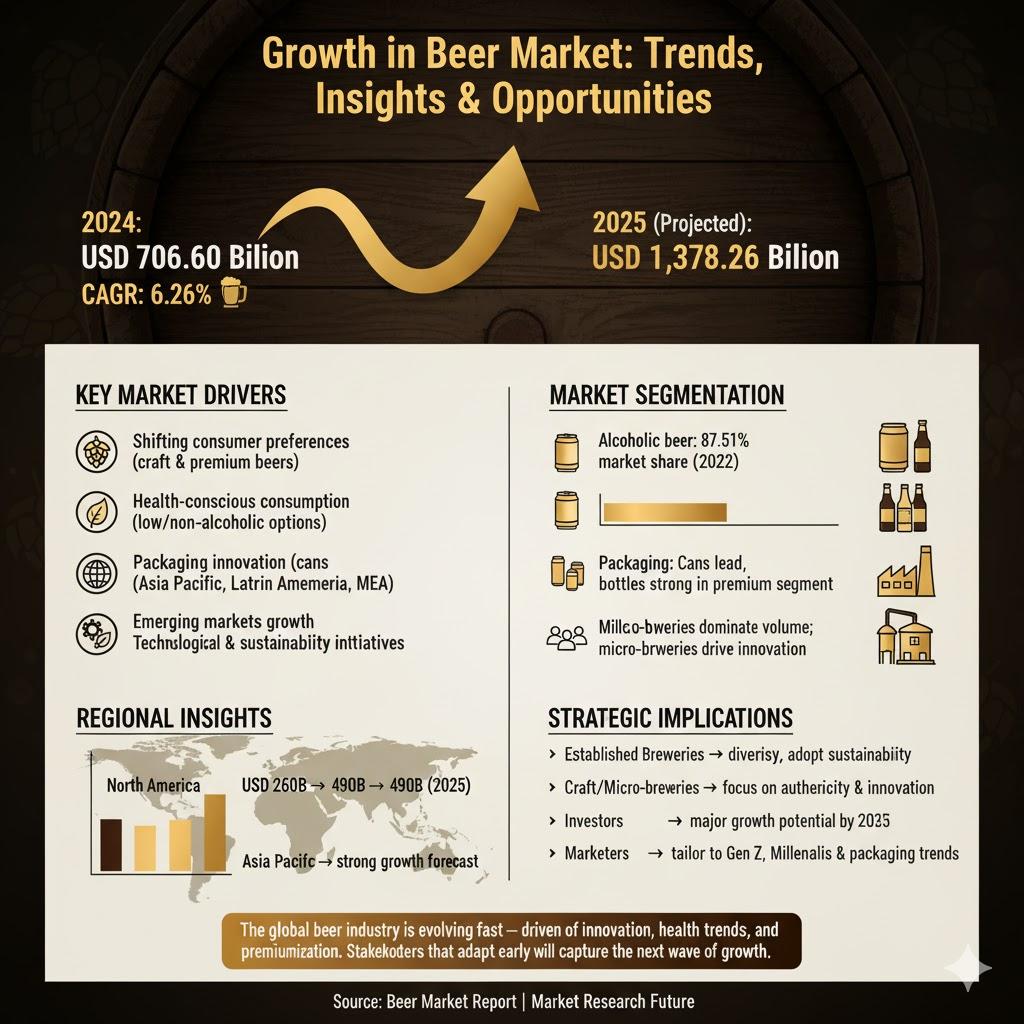The global Beer Market is undergoing a dynamic transformation, with shifting consumer tastes and evolving industry strategies reshaping how brewers compete and grow. According to recent research, this market—the total addressable size of beer as a beverage category—is projected to expand significantly through 2035, driven by innovation, premiumisation and geographic expansion.
Market Snapshot
In 2024, the beer market was valued at approximately USD 706.6 billion. Forecasts indicate growth to around USD 1,378.26 billion by 2035, representing a compound annual growth rate (CAGR) of about 6.26 %. Within this longer-term projection (2025–2035), a more conservative CAGR of ~5.69% is also cited. Meanwhile, younger demographics—Millennials and Gen Z—play an increasingly influential role, opening doors to new tastes and formats.
Key Growth Drivers
Premiumisation & craft beer growth: Consumers around the world are upgrading their choices toward craft brews and “better-for-you” styles. Smaller breweries are rising, and legacy players are adapting.
Health & wellness trends: A notable shift toward low-alcohol and alcohol-free beer options is underway, as part of broader consumer wellness awareness.
Packaging & convenience: The cans segment leads in packaging, due to its portability, convenience, and recycling benefits—factors especially important for younger consumers.
Emerging markets: Regions such as Asia-Pacific, Latin America and parts of Africa show accelerating beer consumption as disposable incomes rise and lifestyles change.
Technology & sustainability: From brewing automation to sustainable packaging, innovation is influencing both cost efficiencies and brand positioning.
Segmentation Highlights
- Packaging: Cans held a significant share in recent years (~53.92% in 2022) while bottles remain strong especially for craft segments.
- Category: Alcoholic beer remains dominant (around 87.51% share), with non-alcoholic and low-alcohol segments growing faster.
- Production type: The market remains dominated by macrobreweries, but microbreweries and craft breweries are important sources of growth and differentiation.
- Consumer groups: Millennials lead consumption, but Gen Z and even older segments are influencing product innovations and marketing.
- Distribution channels: Traditional on-premises (bars, restaurants) remain vital, but off-premises retail (supermarkets, online) are gaining share—especially post-pandemic.
Regional Outlook
- North America: The largest regional market in value terms; valued at approx USD 260 billion in 2024 and projected to reach ~USD 490 billion by 2035.
- Europe: Valued at about USD 230 billion in 2024, with forecast growth to around USD 430 billion by 2035.
- Asia-Pacific: Despite starting smaller (~USD 120 billion in 2024), strong demographic and income trends place it on an accelerated growth path toward ~USD 210 billion by 2035.
- South America & MEA: Smaller in absolute size, but growth potential is meaningful as beer culture spreads and infrastructure improves.
Challenges and Strategic Imperatives
While growth prospects are strong, the beer market is not without headwinds. Saturation in mature markets, regulatory pressures (taxation, advertising restrictions), supply-chain volatility and shifting consumer attitudes toward alcohol consumption all pose risks. Brewers must therefore:
- Invest in innovation (new styles, flavors, formats)
- Focus on premium and health-oriented sub-segments
- Expand into emerging markets with localised strategies
- Build sustainability credentials (eco-friendly packaging, responsible drinking)
- Leverage e-commerce and digital marketing channels
Why the “Beer Market Size” Matters
Understanding the Beer Market Size is critical for any stakeholder — whether brands, investors or distributors. It provides the benchmark against which growth rates are measured, opportunity zones identified and strategic investments justified. From a marketing standpoint, knowing how large the addressable pie is, and how quickly it’s growing, enables companies to select which sub-segments to pursue and how aggressively.
Outlook Summary
In sum, the beer industry is set for robust expansion through the coming decade. With a projected doubling in value from 2024 to 2035, the opportunity is significant for companies that can stay nimble, consumer-centric and regionally adaptable. The competitive landscape will favour those who embrace health & wellness trends, premiumisation, sustainability and emerging market growth.
For anyone tracking the trajectory of this global beverage segment, the evolving beer market presents both promise and complexity—and those who understand these dynamics will be best positioned to capture value.

